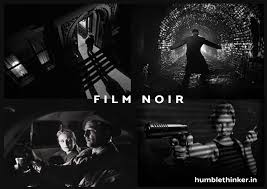Bollywood has long been celebrated for its vibrant colors, elaborate song sequences, and emotional storytelling. However, beneath the surface of its glossy exterior lies a darker, more introspective realm of filmmaking: the world of noir and neo-noir cinema. These genres, steeped in themes of moral ambiguity, crime, and psychological depth, have been gaining prominence in Bollywood’s cinematic landscape. But what distinguishes traditional noir from its modern counterpart, neo-noir, and how has Bollywood interpreted and evolved these genres? Let’s delve into the fascinating contrasts and intersections between Bollywood’s noir and neo-noir films.
What is Noir? A Brief Overview
Noir, short for “film noir,” emerged in Hollywood during the 1940s and 1950s, characterized by its stark black-and-white visuals, shadowy lighting, and morally complex narratives. These films often featured anti-heroes, femme fatales, and an overarching sense of doom. Noir films explore the darker facets of human nature, focusing on themes like betrayal, greed, and existential despair.
Bollywood’s Take on Noir
Bollywood’s early experiments with noir were deeply influenced by this Western cinematic style, blending it with local storytelling traditions. Films like “Madhumati” (1958) by Bimal Roy are often considered pioneers of the genre in Indian cinema. With its haunting atmosphere and tragic love story set against a backdrop of betrayal, “Madhumati” exemplifies how Bollywood adapted noir’s visual and narrative elements.
Other notable examples include Guru Dutt’s “Pyaasa” (1957) and “Sahib Bibi Aur Ghulam” (1962), which delve into societal decay, unfulfilled desires, and moral dilemmas, all hallmarks of noir storytelling.
Neo-Noir: A Modern Evolution
Neo-noir is not merely an extension of noir; it’s a reimagining. Emerging in the 1970s, neo-noir films retain the thematic essence of noir but adapt to modern sensibilities and technological advancements. Unlike traditional noir, neo-noir often features color palettes, contemporary settings, and an expanded range of moral and ethical questions. It explores not just the darkness within individuals but also the societal structures that perpetuate corruption and injustice
Bollywood’s Neo-Noir Renaissance

In recent decades, Bollywood has embraced neo-noir with fervor, producing critically acclaimed films that push boundaries and challenge conventions. Directors like Anurag Kashyap, Vishal Bhardwaj, and Sriram Raghavan have led the charge in crafting compelling neo-noir narratives.
Key Films in Bollywood Neo-Noir:
- “Black Friday” (2007): Directed by Anurag Kashyap, this gritty crime drama explores the aftermath of the 1993 Bombay bomb blasts. With its raw realism and unflinching portrayal of systemic corruption, it’s a quintessential neo-noir masterpiece.
- “Johnny Gaddaar” (2007): A taut thriller by Sriram Raghavan, this film blends suspense with moral ambiguity, capturing the essence of neo-noir with its intricate plot and flawed characters.
- “Talaash” (2012): Starring Aamir Khan, this psychological thriller intertwines supernatural elements with a classic detective story, creating a unique neo-noir experience.
- “Badlapur” (2015): Another Sriram Raghavan gem, “Badlapur” explores themes of vengeance and moral compromise, challenging the audience’s perception of right and wrong.
Contrasting Noir and Neo-Noir in Bollywood
While both noir and neo-noir delve into the darker aspects of human existence, their stylistic and thematic approaches differ significantly. Here’s how Bollywood’s interpretation of these genres sets them apart:
1. Visual Aesthetics
- Noir: Often relies on chiaroscuro lighting, with high contrasts between light and shadow. Early Bollywood noir films like “Madhumati” adopted these techniques to evoke a sense of mystery.
- Neo-Noir: Embraces a broader color palette, utilizing lighting and modern cinematography to create tension. Films like “Talaash” and “Badlapur” exemplify this shift.
2. Narrative Complexity
- Noir: Focuses on straightforward tales of crime, betrayal, and moral conflict. The narratives are tightly woven, with a sense of inevitability.
- Neo-Noir: Explores layered and often non-linear storytelling. Themes of psychological trauma, existentialism, and societal critique are more pronounced in neo-noir films like “Black Friday.”
3. Cultural Context
- Noir: Bollywood’s noir films often incorporated melodrama and music, blending Western styles with Indian sensibilities.
- Neo-Noir: Adopts a grittier, more realistic approach, often shedding traditional Bollywood elements like song-and-dance sequences.
Why Bollywood’s Dark World Resonates
The resurgence of noir and neo-noir in Bollywood reflects a growing appetite for nuanced storytelling among Indian audiences. These films offer a mirror to society, challenging viewers to confront uncomfortable truths about morality, justice, and the human condition.
Moreover, the global success of neo-noir films like “Gangs of Wasseypur” has demonstrated the universal appeal of these narratives, proving that Bollywood’s dark world has a place on the international stage.
Bollywood’s journey through the realms of noir and neo-noir is a testament to its versatility and evolving artistic vision. While traditional noir laid the groundwork with its timeless tales of despair and duplicity, neo-noir has pushed the boundaries, exploring contemporary issues with unprecedented depth and complexity.
As filmmakers continue to experiment with these genres, Bollywood’s dark world promises to remain a compelling and thought-provoking space, challenging audiences and redefining cinematic storytelling.
FAQ
1. What is the difference between noir and neo-noir?
Noir is characterized by its classic black-and-white visuals, moral ambiguity, and straightforward storytelling, while neo-noir adapts these themes to modern contexts, using contemporary settings, color, and complex narratives.
2. Which are the best Bollywood noir films?
Classic examples include “Madhumati” (1958), “Pyaasa” (1957), and “Sahib Bibi Aur Ghulam” (1962).
3. What defines a Bollywood neo-noir film?
Bollywood neo-noir films often feature gritty realism, layered storytelling, and contemporary social issues, as seen in movies like “Black Friday” and “Badlapur.”
4. Who are the leading directors in Bollywood’s noir and neo-noir genres?
Notable directors include Anurag Kashyap, Vishal Bhardwaj, and Sriram Raghavan, who have all contributed significantly to these genres.
5. Why are noir and neo-noir genres gaining popularity in Bollywood?
These genres resonate with audiences seeking complex, thought-provoking narratives that explore the darker sides of human nature and society.
Explore the fascinating contrasts between Bollywood’s noir and neo-noir films. Discover how these genres delve into crime, morality, and societal darkness, reshaping Indian cinema.
